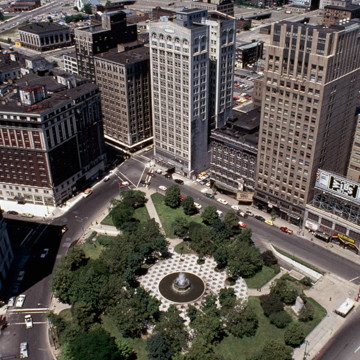Grand Circus Park is the northernmost culmination of the city plan devised by Judge Augustus Woodward in 1805–1807. The city established the park in 1850. By the 1860s the park was surrounded by villas and mansions. The Gothic Revival limestone Central Methodist Episcopal Church (1866–1867, Gordon W. Lloyd) is evidence of the area's original noncommercial character. Between 1890 and 1930 the streets surrounding and leading to the park were built up with high-rise, high-quality commercial skyscrapers, hotels, and movie palaces. Among them at the southwest corner of Woodward and Park avenues is the David Whitney Building (1915, Daniel H. Burnham). The corridors of the professional office building face an interior court, and the offices have outward-facing windows.
Standing in the park are statues depicting and memorializing prominent Detroit and Michigan public figures, including Detroit mayor and Michigan governor Hazen S. Pingree (1840–1901), U.S. senator Russell A. Alger (1836–1907), and Detroit mayor William Maybury (1848–1909). Henry Bacon designed the Russell Alger Memorial Fountain (1921), and Daniel French sculpted a classic Roman figure symbolizing Michigan contained therein. A parking garage was constructed beneath the park in 1956. Circumnavigating the park's south side is the People Mover ( WN8).


